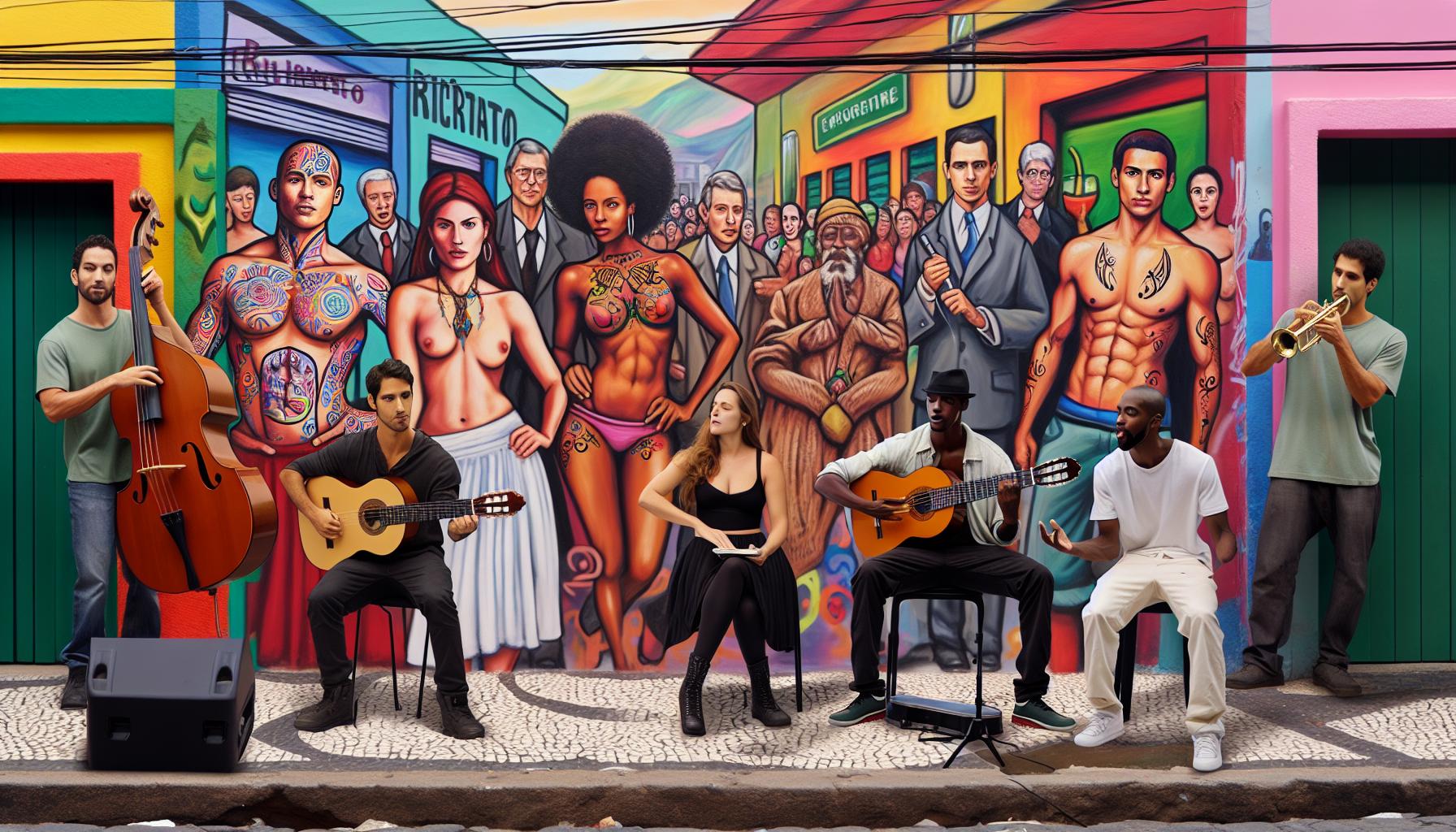In the vibrant world of Brazilian culture, “pornofarioca” stands out as a provocative and multifaceted phenomenon. This term blends the essence of Rio de Janeiro’s unique lifestyle with a bold exploration of sexuality, art, and media. Originating from the fusion of “pornography” and “Carioca,” it reflects the city’s spirited identity and its complex relationship with desire and expression.
As societal norms evolve, so does the conversation surrounding pornofarioca. This movement challenges traditional boundaries, inviting discussions about freedom, creativity, and the human experience. From underground art scenes to mainstream acceptance, it captures the attention of artists, scholars, and the general public alike. Understanding pornofarioca offers a glimpse into the heart of modern Brazilian culture and its ongoing dialogue about sexuality and identity.
Pornofarioca
Pornofarioca represents a cultural movement that intertwines elements of art, sexuality, and identity within the Brazilian context. Originating in Rio de Janeiro, this phenomenon embodies a daring expression of sexuality and challenges conventional social norms.
Artists and performers actively engage with pornofarioca, using it as a medium to provoke thought and stir discussions around themes of freedom and creativity. Events, exhibitions, and performances showcase various forms such as photography, live art, and multimedia displays, emphasizing the human experience through an unapologetic lens.
The movement’s significance extends beyond entertainment, as it prompts critical conversations about personal and societal perceptions of sexuality. Scholars and commentators analyze pornofarioca’s impact on Brazilian culture, revealing how it reflects broader trends in identity politics and sexuality. This ongoing dialogue emphasizes the transformative role of art in societal evolution and the power of self-expression in challenging existing paradigms.
Overall, pornofarioca serves as a testament to Rio de Janeiro’s dynamic cultural landscape, embodying the city’s spirit while inviting introspection and celebration of one’s identity.
Historical Background

Pornofarioca reflects a complex interplay of culture, sexuality, and identity within Brazilian society. The roots of this movement can be traced back to various socio-political factors that influenced its emergence.
Origins of Pornofarioca
Pornofarioca originated in Rio de Janeiro, emerging during a period of significant cultural transformation in the late 20th century. The sexual revolution of the 1960s set the stage by challenging social mores and encouraging more open expressions of sexuality. Amidst Brazil’s dynamic political landscape, artists began to explore themes of eroticism through their works, creating a space for dialogue about personal freedom, sexual identity, and the body. This movement combines traditional Carioca elements with contemporary artistic expressions, forming a unique cultural phenomenon.
Evolution Over Time
Over the years, pornofarioca evolved in response to shifting societal attitudes and technological advancements. The early 2000s saw a surge in online platforms that allowed artists to reach broader audiences, thereby expanding the movement’s influence. Performance art, film, and digital media became essential vehicles for exploring sexuality and identity, pushing boundaries further. Academic discourse surrounding pornofarioca increased, with scholars examining its implications on identity politics and sexual representation. Today, the movement continues to inspire new generations of artists, fostering ongoing conversations about culture, sexuality, and personal expression in Brazil.
Cultural Impact

Pornofarioca significantly shapes Brazilian culture, influencing societal norms and media representation. This movement ignites conversations around sexuality, identity, and freedom of expression.
Influence on Society
Pornofarioca challenges traditional societal norms, inviting individuals to explore their sexual identities. Artists and performers use provocative themes to provoke critical thought. Public performances and art installations create platforms for discourse, often addressing issues like gender inequality and sexual repression. This movement fosters inclusivity, encouraging diverse expressions of identity within Brazilian society.
Representation in Media
Media representation of pornofarioca spans various formats, including film, digital art, and social media. Artists leverage these platforms to present bold narratives that highlight sexuality and cultural identity. Documentaries and feature films explore the movement’s roots and impact, contributing to academic discussions about representation. Online platforms enable wider access, allowing marginalized voices to share their stories. As a result, viewers engage with challenging content that promotes understanding and acceptance of diverse sexual expressions.
Artistic Elements

Artistic elements of pornofarioca reflect a bold fusion of sexuality, culture, and identity within Brazilian art. The movement showcases distinctive features and contributions from key artists that shape its narrative.
Unique Features of Pornofarioca
Pornofarioca exhibits unique characteristics that set it apart from traditional art movements. Key features include:
- Erotic Imagery: Artists utilize explicit visual representations, exploring themes of desire and intimacy.
- Multimedia Integration: Incorporation of various formats such as performance art, video installations, and digital media enhances storytelling.
- Cultural Commentary: Art often critiques societal norms, addressing issues like gender roles and sexual freedom.
- Public Engagement: Performances in public spaces invite community participation, fostering dialogue around sexuality and identity.
- Transgressive Themes: Works often challenge conventional artistic boundaries, pushing societal limits on acceptable expression.
Notable Artists and Works
Several artists have significantly contributed to the pornofarioca movement, each bringing a distinct voice and perspective:
- Leandro Erlich: Known for installations that blur reality and eroticism, encouraging viewers to confront their perceptions of desire.
- Cláudia Dias: Her performances address gender inequality through provocative narratives, highlighting women’s experiences in Brazilian society.
- Marcos Chaves: Utilizes humor and irony in his visual art to critique cultural taboos surrounding sexuality.
- Tânia Carvalho: Combines dance and video to explore themes of sensuality, creating immersive experiences that challenge viewers’ perceptions.
- Felipe Cb: Focuses on digital art, using social media to spread messages of inclusivity and acceptance in sexual identity.
These artists and their pioneering works underscore the cultural significance of pornofarioca, reinforcing its role as a catalyst for change and conversation in contemporary Brazilian society.
Criticism and Controversies
Pornofarioca faces various critiques that stem from its provocative themes and societal implications. Critics often highlight concerns regarding objectification, exploitation, and the potential normalization of explicit content within public spaces. These criticisms provoke discourse about the ethical dimensions of artistic expression and the responsibility of creators within the cultural movement.
Common Critiques
- Objectification: Critics argue that pornofarioca may perpetuate the objectification of individuals, particularly women, leading to reduced personal agency and reinforcing traditional gender roles.
- Exploitation: The movement faces accusations of exploiting marginalized performers who may feel pressured to conform to sensationalized standards for success in the arts.
- Impact on Youth: Concerns arise regarding the exposure of younger audiences to explicit content, with critics stressing that it might negatively influence their perceptions of sexuality and relationships.
- Cultural Appropriation: Some critics perceive the movement’s fusion of sexuality and Brazilian culture as a potential appropriation that trivializes significant cultural elements.
- Role of Technology: The proliferation of pornographic content on digital platforms raises questions about authenticity and the commodification of sexual expression within the movement.
- Emphasis on Agency: Many creators assert that pornofarioca empowers individuals by allowing them to reclaim their narratives and express their sexuality on their terms.
- Artistic Freedom: Advocates highlight the movement’s role in pushing the boundaries of artistic freedom within Brazilian society, promoting dialogue around crucial social issues.
- Challenging Norms: Artists aim to challenge outdated perspectives on sexuality, urging society to engage with complex discussions about identity, expression, and modern relationships.
- Community Support: The movement fosters community engagement, with many creators participating in workshops and discussions to educate audiences about sexuality and artistic intent.
- Inclusivity: Many proponents emphasize that pornofarioca celebrates diverse identities, encouraging underrepresented voices to share their experiences and narratives.
Pornofarioca stands as a bold reflection of Brazil’s evolving cultural landscape. It pushes the boundaries of artistic expression while challenging societal norms surrounding sexuality and identity. As it continues to inspire new generations of artists and thinkers, the movement fosters vital discussions about personal freedom and inclusivity.
Despite facing critiques, the essence of pornofarioca lies in its ability to empower individuals to reclaim their narratives. Through provocative art and performance, it invites audiences to engage with complex themes of eroticism and cultural identity. This ongoing dialogue not only enriches Brazilian culture but also paves the way for greater understanding and acceptance of diverse expressions of sexuality.
